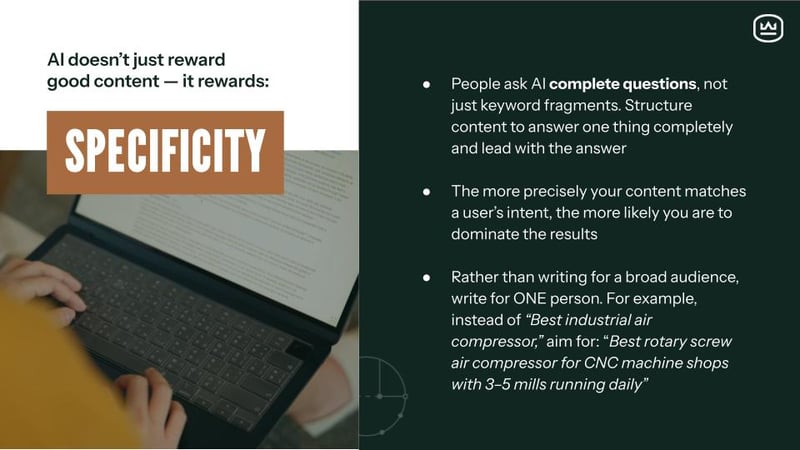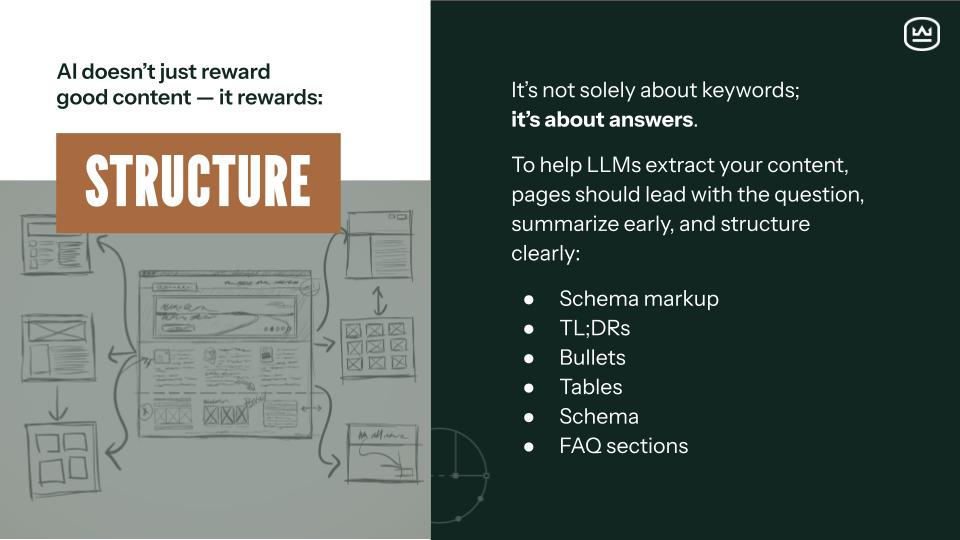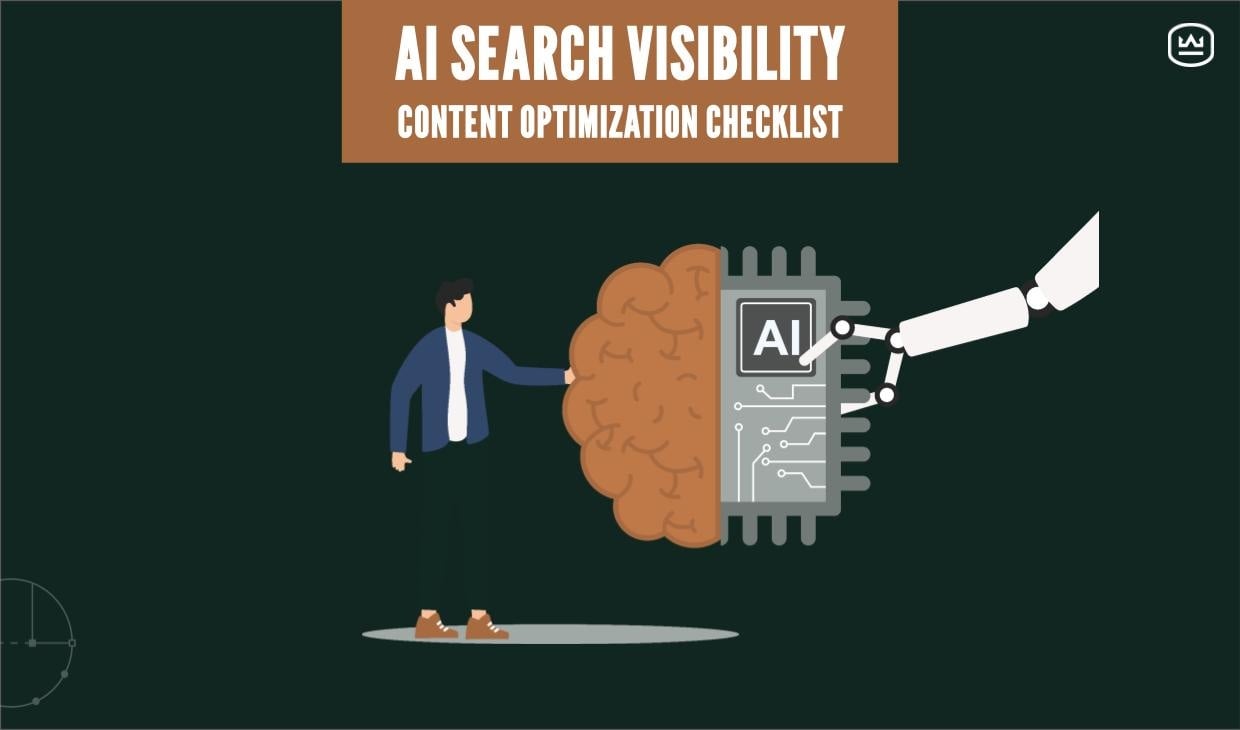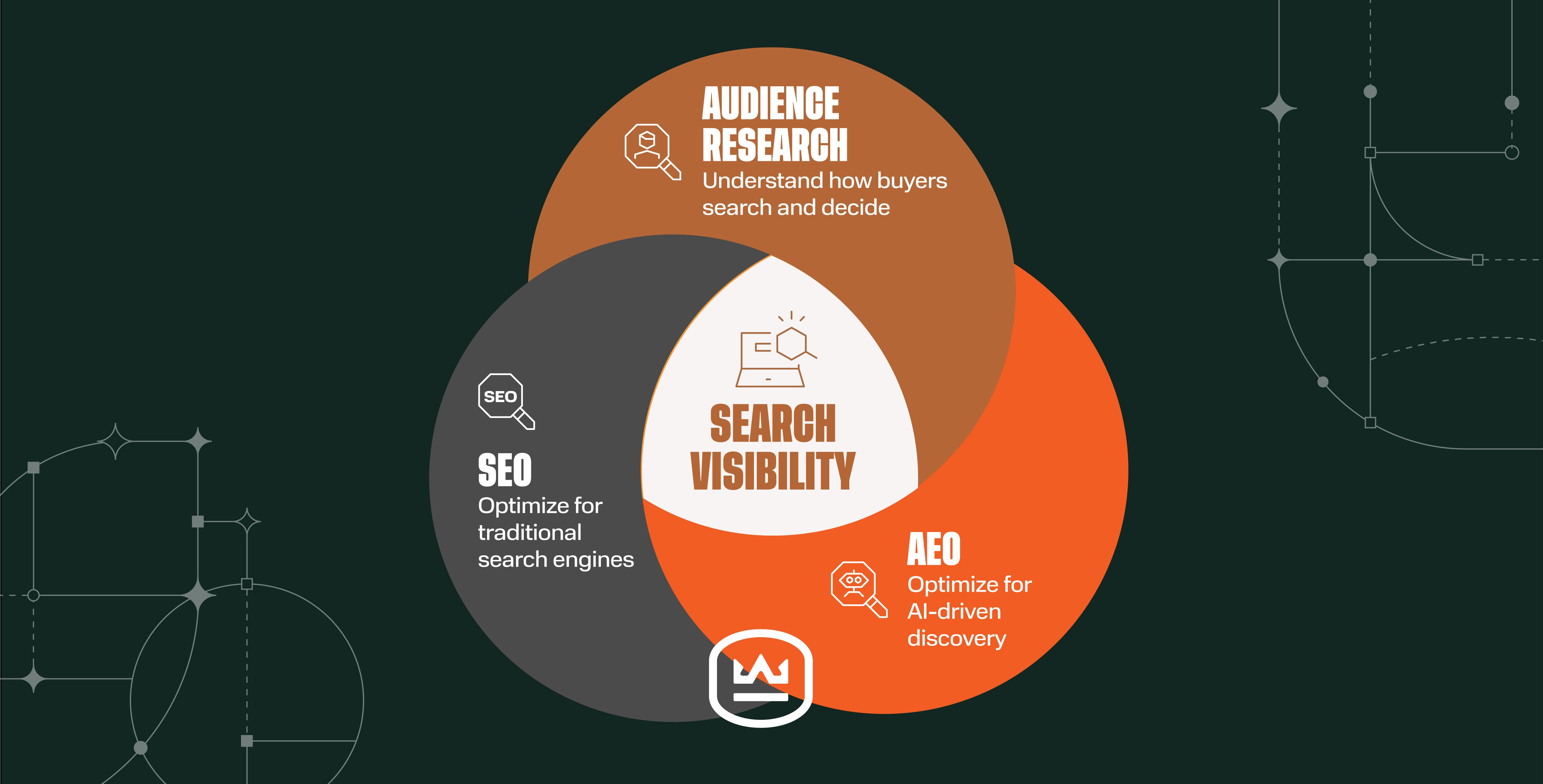The New Search Visibility Checklist for AI-Era Content Marketing
Written by
Optimizing for AI search means optimizing for meaning, not just metadata. This article explains how to make content that’s discoverable, retrievable, and trusted across AI Overviews, ChatGPT, and other generative search experiences.
The Ground Beneath Search Has Shifted
Online search has evolved from a simple list of blue links to an experience of answers gathered, synthesized, summarized and served up, increasingly by AI. Google’s AI Overviews, ChatGPT, Perplexity, and Gemini are redistributing attention and redefining what visibility means.
The question for marketers is no longer, “How do we rank?”
It’s, “How do we get found, trusted, and surfaced by the machinery that recommends us to humans?”
Recognition requires not only technical optimization, but clarity of message and depth of authority — the kind of content that humans find useful and machines can understand.
Why Optimizing for AI Search is Not Just “New SEO”
Classic SEO rewarded well-structured pages aligned to specific keyword intent. Marketers can think of AI search as raising that bar. It rewards clarity of meaning: content that AI models can easily parse, cite, and trust.
The core search visibility principles haven’t disappeared but they have broadened. Keyword research still matters, but now it’s joined by entity relationships, semantic context, and outcome intent.
Old-school SEO asked, “What terms are people typing?” AI search asks, “What problem are they trying to solve … and can your brand explain it clearly?
RELATED: Part 1 of our Search Visibility series, "SEO Isn't Dead. It's Evolving. How B2Bs Can Stay Visible in the Age of AI"
|
Traditional SEO |
AI search optimization |
|
Keywords & topic clusters |
Entities & relationships |
|
Snippet optimization |
Chunk-level retrievability |
|
Metadata & schema |
Structured data & semantic clarity |
|
E-A-T (expertise, authority, trust) |
Proven first-person experience, expertise + consistent entity recognition |
In short: we’re no longer just optimizing for discovery; we’re optimizing for comprehension. Here’s a methodical way to think about it...
Step 1. Anchor Every Piece in Intent
A strong visibility strategy starts before a single word is written, with the intent to answer a specific question or fulfill a distinct outcome. That’s how both humans and AI systems interpret relevance.
For example, a typical service page on a website might have opened with, “We offer a range of industrial automation solutions.”
But instead, a page organized around “What is industrial automation?” and “How do you choose the right system?” — delivers a standalone, scannable answer with each section.
When content maps directly to intent, it becomes easier to navigate, cite, and reuse — which is precisely how AI retrieves and recombines information.

Step 2. Design for Modular Reading
Once intent is clear, structure becomes strategy. Think in chunks, not paragraphs. Every section should make sense when read in isolation because that’s often how it will be consumed — whether by a human skimming on mobile or an LLM scanning for context.
Checklist:
- One H1, clear H2/H3 hierarchy
- Subheads phrased as questions
- 30–50-word answer summaries up front
- Lists and comparisons for clarity
This approach keeps content flexible. Generative engines frequently cite or summarize a single content section. Modular content helps ensure that whichever module of your content is used by AI, your brand is represented accurately.
Step 3. Write for Comprehension (Not Just Keywords)
Once structure is set, tone and phrasing determine whether your meaning stays intact as it's digested, synthesized, and served up. AI understands context, not just keywords, so favor semantic depth over density:
|
Before |
After |
|
“HubSpot CRM software helps businesses manage leads. HubSpot CRM is the best CRM for sales.” |
“HubSpot, a leading customer relationship management (CRM) platform, connects sales, marketing, and service data — giving teams a unified view of every customer.” |
Both sentences discuss the same product, but the latter conveys relationships and relevance, key signals AI uses to understand expertise.
Step 4. Make Expertise Visible
While the technology’s advancing, credibility is still the currency of search. Humans and machines both look for cues that say, “This source knows what it’s talking about.”
That means going beyond generic bylines. Include subject matter expert credentials, cite reputable data, and timestamp updates. Publish original insights wherever possible: your own analysis, benchmarks, experiments, surveys, etc.
Visible expertise builds trust — and trust fuels visibility.
Step 5. Build an Entity, Not Just a Website
When your brand is recognized as a consistent, well-defined entity across the web, AI can connect your dots. Entity recognition ensures that citations and summaries accurately attribute ideas to your brand, not someone else.
Checklist
- Use structured data to define your organization
- Keep naming and descriptions consistent across web, social, and directories
- Link to authoritative sources such as Wikidata or your Google Business Profile
Think of this as brand coherence for machines: it helps AI understand who you are, not just what you publish.
Step 6. Remove Technical Friction
All of the effort you put into crafting excellent content collapses if crawlers or readers can’t reach it. Accessibility and performance are also part of credibility.
Checklist
- Use descriptive internal links
- Avoid PDFs for primary information
- Add descriptive alt text to images
- Keep markup clean and semantic
The goal isn’t just faster load times; it’s clarity everywhere. A clean, clear digital structure is a sign of a clear mind, and both humans and algorithms appreciate and reward that.

EXPERIMENT & TEST, Then Trust the Proof
These optimization shifts aren’t theoretical ; they’re measurable.
A strategic service-page restructure might not push your keyword rankings higher, but it can expand your visibility in Gemini’s AI Overviews, where content context and clarity matter more than links.
Adding schema markup to blog or product pages won’t guarantee a rich snippet, but it can increase click-through rates from AI-generated summaries by making your content easier for systems (and humans) to interpret and feature.
Updating author bios with consistent schema, credentials, and profile links can strengthen attribution in ChatGPT’s retrieval-based answers — a growing factor in brand visibility.
Each of these actions shares the same philosophy: modern optimization isn’t about gaming algorithms; it’s about enabling understanding. The faster machines and humans can identify your content’s value — who it’s for, what it offers, and why it matters — the more consistently you’ll surface where it counts.
Test, measure, and refine based on results, not trends. Proof, not promises, is the new best practice.
Your Takeaway: Clarity OutlastS Algorithms
AI search has transformed visibility from a keyword-focused exercise into a multi-audience challenge. Every piece of content must communicate clearly enough for humans to appreciate, and be structured properly for machines to learn from.
The businesses that thrive amid the shift will be those that pair strategic empathy with semantic precision — demonstrating that you understand your audience’s challenges, and offering clear solutions from credible experts that are easy to find, grasp, and act on.
That’s exactly the foundation of our Search Visibility Playbook — our comprehensive diagnostic that uncovers how and where your brand is showing up (or not) across traditional search, AI platforms, and community channels.
Our Playbook explores these critical dimensions:
- SEO snapshot — keyword visibility, traffic shifts, competitor benchmarks
- LLM query testing & output analysis — checking your brand's presence in AI search engines like ChatGPT, Gemini, Perplexity
- Clickstream & audience research — uncovering what your target reads, watches or asks before they engage you
- Social & community audit — your brand’s visibility in LinkedIn threads, Reddit, forums and niche vendor listings (informed by clickstream data)
With this combination of competitive information, performance data, and audience intelligence, we map opportunities by impact and effort intensity, and deliver a scorecard of current visibility, quick-win actions to move the needle fast, and the information to take to stakeholders to support your business case and your marketing budget.
The Search Visibility Scorecard isn’t just a ranking check.; it includes a more comprehensive, nuanced view of your presence in the early, invisible phases of the buyer’s journey.
If you’re ready to see where your visibility stands, and what you can do now to improve it , you’ll want to explore Search Visibility. Click below to see how it works.
Subscribe To Our Blog
Information. Insights. Ideas. Get notified every time a new Weidert Group blog article is published – subscribe now!
You May Also Like...

Search Engine Optimization
How Falcon Rebuilt Industrial AI Search Visibility in 2025

Search Engine Optimization
The New Search Visibility Checklist for AI-Era Content Marketing

Search Engine Optimization
SEO Isn’t Dead. It’s Evolving: How B2Bs Can Stay Visible in the Age of AI
Accelerate Your Growth with
Weidert Group
If you’re ready to explore a partnership, request a personalized consultation with our team.

